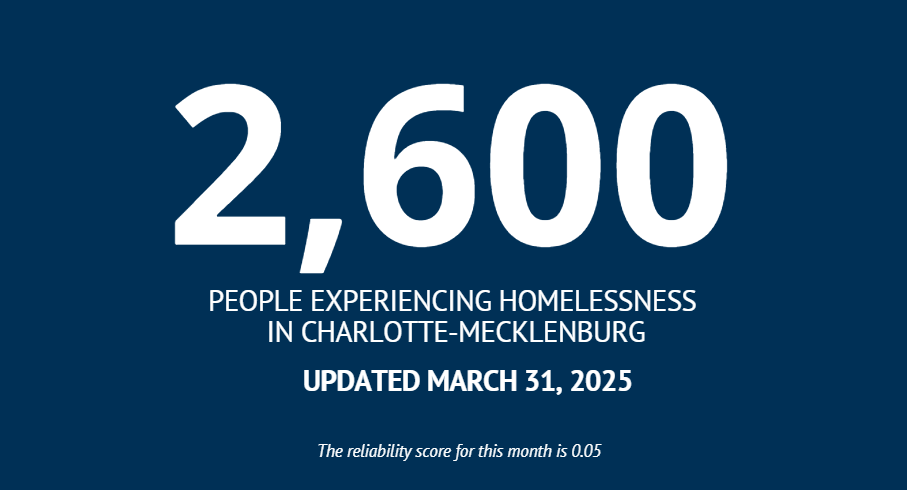Mary Ann Priester
Senior Management Analyst
Mecklenburg County Community Support Services
Since its inception in 2019, the “One Number” has served as the primary benchmark for the number of people experiencing homelessness in Charlotte-Mecklenburg.
Generated from the Homeless Management Information System (HMIS), the One Number encompasses individuals enrolled in Emergency Shelter (ES), Transitional Housing (TH), Street Outreach (SO), Permanent Housing (PH) (if no move-in date to housing is recorded yet) and Coordinated Entry (CE) programs in HMIS. It includes both those experiencing sheltered homelessness and a portion of those experiencing unsheltered homelessness. It also provides a comprehensive By-Name List of each person experiencing homelessness in Charlotte-Mecklenburg.
The Housing Data Snapshot, the hub for the latest data related to housing and homelessness in Charlotte-Mecklenburg, not only provides an overall count and demographics of homelessness by household type and subpopulation, it also highlights inflow to (Newly identified, Returns from Permanent Housing, Returns for Inactivity) and outflow from (Exit to Permanent Housing, Exit to Inactivity), homelessness.
This week’s blog post provides the most recent One Number update; the latest One Number trends and analysis; and what this means for Charlotte-Mecklenburg.
LATEST DATA & TRENDS
As of March 31, 2025, there are 2,600 individuals experiencing homelessness in Charlotte-Mecklenburg. This total includes 1,716 single individuals, 128 unaccompanied youth, 220 households with minor children (totaling 700 people), and 22 families with multiple adults (totaling 39 people). Included in the total of 2,600 individuals, 157 are homeless Veterans, and 700 are individuals who are experiencing chronic homelessness. Based on these data, the minimum number of people experiencing homelessness right now (and therefore, the minimum number of housing units and/or subsidies needed) in Charlotte-Mecklenburg is 2,600.
Considering inflow (into homelessness) and outflow (out of homelessness), here are some noteworthy trends:
- Between February 2025 and March 2025, there was a 70 person decrease in the total number of people experiencing homelessness. There has been a 9% (or 253 person) decrease in overall homelessness since March 2024. As context, as part of the 2025 Point-in-Time Count, staff reached out to each person enrolled in a street outreach program and in the coordinated entry program to verify they were still experiencing literal homelessness. If they could not be contacted or reported they were not experiencing homelessness, they were closed out and removed from the community by-name list resulting in a decrease in the number of people experiencing unsheltered and sheltered homelessness in Charlotte-Mecklenburg.
- In March 2025, 759 individuals entered homelessness (inflow) and 699 people exited (outflow). Of the 759 individuals entering homelessness, 74% (563) were newly identified, 10% (72) returned to homelessness from permanent housing and 16% (124) returned from an inactive status. Of the 699 individuals exiting homelessness, 35% (245) moved to permanent housing and 65% (454) exited homelessness to an inactive status, which means that they had not been engaged in services for the previous 30 days.
- Between February 2025 and March 2025, homelessness decreased among all household types and subpopulations except families with minor children, unaccompanied youth, and veterans. The number of persons in households with minor children increased by 12 people. The number of unaccompanied youth increased by 3; and the number of veterans increased by 5 people. The number of people experiencing chronic homelessness decreased by 15. The number of people in multiple adult households decreased by 5 people; and the number of single adults decreased by 85 individuals. Finally, the median number of days it takes to exit homelessness into housing decreased from 393 days to 221 days and the average number of days it takes to exit homelessness into housing decreased from 762 days to 710 days. The median tells us the typical number of days it takes to exit homelessness into housing while the average includes long-stayers in shelter and people experiencing chronic homelessness.
- According to the most recent One Number data, disaggregated by race and ethnicity, individuals who identify as Black/African American continue to experience homelessness at rates much higher than their proportion of the Mecklenburg County population (74% vs. 33%) while individuals who identify as White, non-Hispanic experience homelessness at a rate much lower than their prevalence in the population (15% vs 45%). Individuals who identify as Hispanic/Latino only have a prevalence of 3% in the homeless population but comprise 14% of the Mecklenburg County population; this reflects a possible underrepresentation of the people who experience homelessness in Charlotte-Mecklenburg and identify as Hispanic/Latino.
SO, WHAT
The One Number is the best snapshot available for the number of people actively experiencing homelessness in Charlotte-Mecklenburg. It provides the most accurate minimum number of people experiencing homeless and provides insights into the minimum number of housing units and subsidies needed today to address their homelessness. These data also provide timely insights into the number of people flowing into and out of the homeless services system by illuminating resource needs and opportunities for system improvement. During the month of March, we saw a continued decrease in overall homelessness but saw an increase in inflow and decrease in outflow. We saw a higher prevalence of first-time homelessness and a higher number of people returning to homelessness after exiting to permanent housing. We saw a significant decrease in outflow. The increase we have seen over the past two months (mostly among exits to inactive) was likely a result of direct follow up with hundreds of people to determine where they slept on the night of the Point-in-Time count and their current housing status. The number of people who exited to permanent housing only dropped slightly from February 2025 to March 2025 (9 people). While we have seen considerable improvements in the overall number of people experiencing homelessness in our community over the past several months, we must continue to focus on both homelessness prevention and permanent housing solutions to make homelessness rare, brief, and non-recurring in Mecklenburg County.


